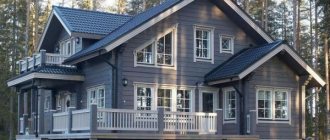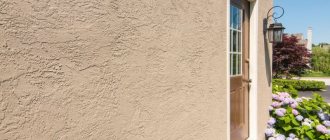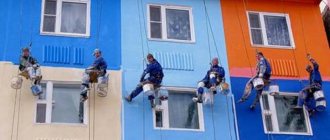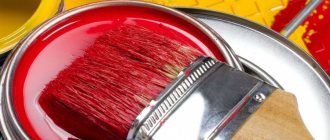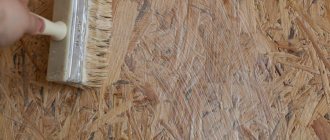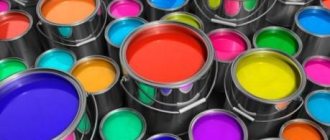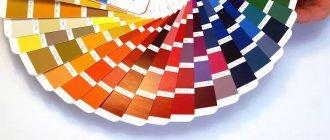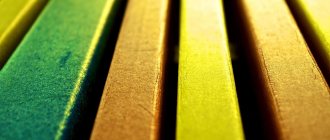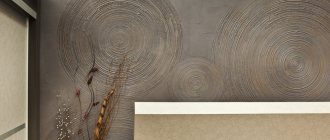Exterior finishing materials come in a variety of types and shapes. Relief coatings that can “revive” the surface have recently become especially popular.
Working with such materials is somewhat more difficult than with ordinary ones; it requires a certain plan and skills in such work. But the result is worth the effort, since it creates an original, stylish surface with a non-standard appearance.
One of these coatings is textured facade paint, the use of which differs significantly from the usual technology for applying external coatings. Let's take a closer look at it.
Characteristics of textured paint
Textured paint is an external coating that creates a relief surface with a different type of pattern and volume. At the same time, the result is determined not only by the composition of the paint. The appearance of the coating largely depends on the application method, as well as on the shape of the tool used . A surface is created in which several properties are harmoniously combined - color, degree of gloss, type and size of the applied relief. There can be a great variety of possible combinations of these properties, which makes each use case original and different from the others.
In order for a material to have such qualities, an unusual physical composition is required - high viscosity, the presence of various fillers (for example, ordinary river sand).
It is the fillers that make it possible to maintain a certain shape and not spread over the entire surface or flow to the ground. The height of the relief can be quite large, and the size of the filler grains determines the ability of a given composition to form a pattern of varying degrees of volume.
In addition, the application method itself allows you to create completely different types of textures from the same material. There are a huge number of options in this matter - the size of the tool, the type of pattern, binding to geometric shapes or complete chaos - all methods are good in their own way and can be used, you just need to have the technique of applying textured paints.
Textured paints can be used on different types of substrates:
- Brick.
- Concrete.
- Plaster.
- Drywall.
- OSB.
- Wood.
- Metal.
- Stone, etc.
IMPORTANT!
The larger the size of the filler, the higher the consumption of material, but also the more options for the design that can be applied with such paint.
In addition to decorative qualities, textured paints also perform other functions inherent in external coatings:
- Protect walls from water penetration.
- Provides steam outlet.
- Eliminates the occurrence of mold, mildew, etc.
Thus, structural paints are the same exterior coatings, but with an enhanced decorative effect.
Application methods
It is impossible to choose a universal tool for finishing with textured paint . Each case will have its own optimal option, depending on many factors. The main thing is not to neglect the removal of the previous layer of material before this, otherwise any advice on choosing a tool will not be able to level out the defects that have arisen. It is also advisable to pre-plaster the surface and cover up large cracks and potholes. It is important to consider that the surface should not have a height difference of more than 2 mm.
Painting with a brush
This method is most relevant in cases where there is a need to apply coloring material to small or complex, angular and narrow areas. It is important that the wall and brush are absolutely clean - this will ensure the best adhesion of the material to the surface .
Before starting work, the coloring material is thoroughly mixed until it reaches a uniform consistency. The paint must be applied in at least two layers: the first by making vertical strokes, and the second by moving the brush in a horizontal plane, which will even out the marks of the brush. However, it is advisable not to make do with two layers and apply a third, consisting of vertical strokes.
Using a roller
The roller is reliable in this regard, as it allows you to create durable coatings . Working with it is fast in large areas, but using a roller in cramped areas can be not only inconvenient, but also ineffective.
When painting with a roller, acrylic paint with a latex base is usually used. A distinctive feature of this paint is its minimal tendency to crumble in the future. As with a brush, the paint is pre-mixed to a uniform consistency, after which it can be applied in one or two layers. If two coats are applied (which is recommended), one is applied from bottom to top and the other from top to bottom.
Sprayer operation
This method is considered the least labor intensive . You need to prepare a clean spray gun, removing dust from all surrounding surfaces and even interior parts, and only then proceed. It is important that the wall on which the texture will be applied is not only clean, but also dry. The paint is sprayed in two layers: from left to right and from right to left. As a rule, complete drying after such painting takes only 24 hours.
Types of textured facade paint
Textured paints differ in size and type of filler . It is this that makes it possible to create a certain structure of the paint layer and imitate some natural textures.
For example, bark beetle paint imitates the surface of wood damaged by insects. “Fur coat” or “lamb” effects, which have a uniformly rough relief of varying heights, are also widespread.
External use somewhat limits the possibilities of textured paints, since weather or atmospheric conditions interfere with the situation. We have to work as quickly as possible, so some types of coatings that are successfully implemented on internal surfaces cannot be performed on the facade.
Most often on today's market you can find textured paints based on water-dispersed acrylic mixtures . They best combine performance, price and performance. However, some manufacturers successfully produce organic solvent-based textured paints using traditional, time-tested materials. Almost all external coatings are certified, have all the necessary qualities, and fully comply with the declared characteristics.
Features and benefits of texture paint
Texture paint is a material that has both the properties of plaster and paint. It is used for brick, wood, plasterboard, concrete, plaster and other types of structures.
Its main advantages:
- long service life;
- resistance to chemicals;
- good environmental and masking properties;
- ease of operation;
- affordable price.
Paints for facades serve several functions: they protect against precipitation and give buildings an aesthetic appearance.
Characteristics of modern material
The facing mixture is a dispersed mass with the addition of acrylic. Color is used for tinting.
Durability implies the absence of defects after long-term use: yellowing, cracking, shedding. Texture paint creates a special impressive look and hides small defects.
High decorative properties and excellent protection from the influence of precipitation - these qualities of the material allow it to be widely used for finishing work: both for restoration and for new buildings.
The textured material is perfect for covering surfaces where increased resistance to destruction is needed.
A wall treated with texture paint has greater resistance to mechanical stress, and is therefore used for finishing walls subject to severe abrasive wear.
Smoothes out cracks, does not emit harmful substances, has no odor, and has high adhesion - these characteristics of facade paint allow it to be widely used for exterior finishing work.
It does not form condensation, has a wide temperature range of use and is resistant to sunlight.
Dark paints are subject to significant temperature fluctuations because they absorb solar radiation, and this factor must be taken into account when choosing a color scheme.
Features of textured facade paint
The use of textured paint for exterior work has its own characteristics. For example, a relief surface does not require a perfectly flat base ; shallow dents or other flaws will be masked by a specific coating pattern.
At the same time, the paint layer turns out to be thicker than usual, which requires the use of special compounds to facilitate drying. In addition, textured facade paints have increased strength, resistance to abrasion, and mechanical stress.
NOTE!
If necessary, you can make textured paint yourself , for which you need to mix the facade paint with putty in the required proportion, add filler - sand, marble chips, etc. The main thing is that the materials are made in the same company and correspond to each other.
Advantages and disadvantages
Textured paint for exterior work is popular primarily because it allows you to hide surface defects. If the wall being treated is in good condition, you will not have to additionally plaster it or remove the old coating from it. Of course, if the coating is peeling or already peeling off, then it is better to remove it, otherwise the new applied paint will peel off along with it.
Note! To give the surface protection from fungus or mold, use special coatings and primers. These are colorless compounds that do not change the appearance of the treated object.
Compared to conventional paint, textured paint is characterized by better resistance to mechanical stress. It is due to this that it is suitable for various surfaces, even those that are exposed to abrasives.
This paint can be used to paint surfaces made of:
- wood;
- drywall;
- bricks;
- concrete;
- plaster.
Due to the high vapor permeability rate, moisture will not be retained in the treated walls. Modern compounds are non-flammable, odorless and do not emit harmful elements into the air during operation. You don't need any special skills to paint the surface. If desired, patterns or reliefs can be easily created. Structural paint for facades is tinted, that is, it is mixed to achieve the desired shade. A popular domestic brand of textured composition is Latek L305.
Structural facade paint also has disadvantages:
- increased consumption - to paint 1 m2, up to 500 g of product is spent, where the layer thickness reaches 10 mm;
- high cost due to consumption and price of the paint itself;
- Due to the created irregularities, dust is deposited on the surface of the wall, so it will have to be cleaned more often.
Textured paint for the facade of a house is a high-quality and sought-after finishing material. And yet, it requires a certain skill during the work.
Advantages and disadvantages
The advantages of textured paint are:
- The ability to create a unique surface pattern and realize any fantasies.
- If you have an old coating that is not of the best quality, you can mask surface imperfections, hide cracks or potholes.
- A more durable coating layer than usual.
- High vapor permeability, moisture-proof properties.
- High frost resistance.
- Durability of the coating.
However, there are some disadvantages:
- Application skills required. The technology is simple, but it may not work the first time, so it’s best to start with inconspicuous areas of the walls.
- High material consumption, which at the same time means high costs.
The advantages and disadvantages of textured paints are quite typical for many finishing materials and do not limit their demand among consumers.
Working with structural paint
This stage is no different from working with conventional paints. Paint is usually sold in closed containers with a thick consistency. In order for the applied layer to be of high quality, it is recommended to dilute the paint with water and then mix thoroughly. The maximum amount of water added for dilution should not exceed 10% of the volume of the paint itself. As a rule, the required consistency is achieved with water in a volume of 2 - 3% of the paint volume.
The difficulty is bringing the paint to the desired color using the appropriate color scheme. In order not to spoil the paint, it is recommended to add color in small portions. After adding a certain portion of the color and thoroughly mixing, the compliance of the color with the specified requirements can be checked by applying it to a small area of the surface. Do not forget that when drying, the color of the paint acquires a dull tint. Therefore, in order to establish a high-quality color match, it is necessary to wait until the paint has completely dried, which can be accelerated with the help of a hairdryer.
Application tool
To apply textured façade paints, a mechanical tool (spray gun) and various types of hand tools are used, which include:
- Rollers with different types of sandpaper.
- Rubber and metal spatulas, straight or serrated.
- Hard brushes with short bristles.
IMPORTANT!
The use of brushes is ineffective, since the brush is designed to smooth and evenly distribute paint, and the specificity of textured compositions requires the formation of relief.
To form the “bark beetle” structure, a grater is often used, which makes it possible to form grooves and stripes characteristic of this type of relief. You can also use a rubber or Teflon spatula.
Surface preparation
Before starting work, it is necessary to clear the surface of the walls from all foreign hanging objects, fasteners, brackets, lanterns, etc. It is recommended to remove trim from window and door openings.
To apply textured paint it is not necessary to have a perfectly flat surface . If the flaws on it are small in size and depth comparable to the height of the relief, then it is not necessary to make any preparation.
However, if there are peelings or shedding of the surface, they should be removed, for which all problem areas must be removed with a spatula . The resulting dents and irregularities should be plastered and a layer of deep penetration primer applied. The layer of plaster should be left for at least a week to complete the crystallization processes and remove alkali from the composition.
Surfaces previously coated with oil paints or enamels should be cleaned of old layers and thoroughly primed.
Application technology
When using a spray gun (spray gun), a surface with uniform roughness is obtained . It will not be possible to apply a specific design in this way, but this method is optimal for reducing time and increasing productivity.
Manual application of textured paints is carried out using one of the selected tools. The roller makes it possible to create a structure with a fine relief (if the roller is smooth) or with a larger one (if a long-pile sandpaper is used).
Using a spatula makes it possible to create various geometric shapes, repeated in different variations or sizes . At the same time, the presence of a large number of heterogeneous relief elements on one wall is visually perceived as a chaotic pile-up, sloppy work.
It should be remembered that any, even the most asymmetrical, pattern obeys certain laws and must have some kind of logic or repeatability. Practice shows that figures that are not too complex , having approximately equal area and not too large in size, look most impressive.
When choosing a design, you should constantly limit yourself so as not to overdo it with elements that are too confusing and sloppy.
The use of textured facade paints creates a complete exterior coating that has high performance qualities combined with an enhanced decorative effect. The complexity of application and increased paint consumption are fully justified by the result obtained, creating a stylish, original look for the facade of the house.
If you do not have the skills to work with such materials, it is better to invite a specialist, or at least start working from the rear walls, invisible from the street. In any case, the result will be a unique design that decorates the walls of your home.
Application Features
There are several ways to apply textured paint to a surface, which will determine its consumption and the resulting relief. On average, consumption varies from 500 to 1500 g per 1 m2. This is explained by the fact that the textured coating has a large thickness, reaching several mm, which is required to create a characteristic relief. During application, various tools are used that affect the depth of the surface. Let's take a look at the popular options.
Sponge
The procedure, although long, is effective. To get an interesting pattern, the sponge should be moistened with the coloring composition, and then treat the surface with “blotting” movements. If you need to achieve a relief texture, it is recommended to use a sponge with high porosity. If necessary, purchase a sponge specially designed for such cases - a natural sea sponge - from a hardware store.
The procedure itself looks like this:
- Prepare the base.
- Painted in the desired color.
- Dip the sponge in the dye.
- Press tightly to the surface, achieving a characteristic effect.
The advantage of using a sponge is that it opens up wide design possibilities - you can practically draw on a surface with it. To create reliefs, unique stencils are used.
Roller
This is the standard option and provides the most durable and long-lasting coating. Work is carried out, as a rule, in a vertical position, smoothly moving from one corner of the room to another. When finishing facades, it is more convenient to use scaffolding or a stepladder. The paint is applied generously, and the roller is often dipped into the paint mixture. This way the relief and expressiveness of the coating is achieved. To achieve an interesting effect, special rollers with a relief pattern on the working surface are now produced.
There are also coloring tricks. For example, to imitate bamboo stems on the surface, a thick rope is wound around a roller. Many items are available for processing: from newspapers and rags to combs. This allows you to create a unique and inimitable facade decor. A roller is the most convenient tool for painting, but once you start work, you should not leave it for later, otherwise the boundaries of the transitions will be noticeable.
Trowel
This is the name of a hand tool, which is a steel spatula with a handle made of wood or plastic. If the composition is applied with it, the paint becomes thicker, similar to putty. The coloring composition is applied to the working surface of the trowel, after which, like putty, it is applied to the surface. To distribute the composition, leveling movements are made. During the work, you should be careful not to leave unpainted areas.
Using a trowel is a good decorative technique: take a small tool, with which you make specially rough strokes. An alternative option: a 2-3 mm layer of paint is applied to the wall surface, after which it is leveled with a roller. The force of pressure on the trowel varies, so certain visual effects are achieved, similar to the paintings of expressionist artists.
Applicator
Using a relief applicator, a texture is created that is visually similar to wood. When working with this hand tool, it is recommended to apply paint in several stages, because one area may dry out while processing another. An applicator is a simple option for applying texture paint to a surface. The work looks simple: first, a coloring composition is applied to the wall, after which an applicator with a textured pattern is used.
In general, working with the applicator is similar to painting with a sponge. These are the same pressing movements, except that the drawing turns out to be more complex and interesting. It takes a lot of time to process the surface.
Spray gun
Using a sprayer is the easiest way to apply texture paint to a surface. The work is not complicated: the spray gun is held in a perpendicular position relative to the wall being painted, after which paint is sprayed onto it in 2 layers (from left to right, and from right to left). Using a spray gun, various surfaces, both smooth and structured, are painted.
But, you need to have certain skills in working with this tool, namely, know what viscosity of paint to use and what nozzles to install on the sprayer. In order to evenly apply the composition to the surface, it is advisable to already have similar work experience. If the skills are not enough, it is recommended to seek help from specialists to paint the facade.
